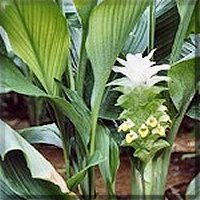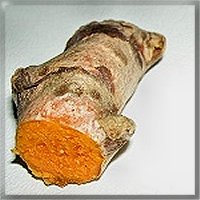

Curcuma longa


Curcuma longa
Origin - India
Part of the plant used - Rhizome
Description - Turmeric has long been considered an essential flavoring spice of Indian and other ethnic cuisines. Turmeric provides the typical yellow color of many curry dishes and helps to render food more digestible. Turmeric along with other curry herbs has several physiologic activities, including the inhibition of platelet aggregation antibiotic effects, anticholesterol action and fibrinolytic activity.
Pharmacology - Many studies on turmeric have revealed that the herb contains cholagogue-type substances which increase the secretion of bile. Principal among these substances is curcumin also posesses liver protective activity, detoxifying dangerous carcinogens, stimulating the gall bladder and acting as a free-radical scavenger. Curcumin has cholekinetic activity (bile duct stimulation). It has been suggested that tumeric lowers blood cholesterol through these various choleric effects. Tumericís effects on weight loss my also be mediated through curcumin's catabolic and metabolic activities on fats. Studies have also revealed that curcumin has anti-inflammatory properties, inhibiting platelet aggregation and cyclooxgenase and lipoxygenase enzymes which catalyze the formation of inflammatory prostaglandins and molecules. Curcumin requires the presence of the adrenal glands to have this non-steroidal anti-inflammatory activity.
Chemical Constituents - 1,8-cineole, 2-bornanol, 2-hydroxy-methyl-anthraquinone, 4-hydroxy-cinnamoyl-(Feruloyl)-methane, Alpha-atlantone, Alpha-pinene, Alpha-terpineol, Ar-turmerone, Arabinose, Ascorbic-acid, Ash, Azulene, Beta-carotene, Beta-pinene, Beta-sesquiphellandrene, Bis-(Para-hydroxy-cinnamoyl)-methane, Bis-desmethoxycurcumin, Bisabolene, Borneol, Boron, Caffeic-acid, Calcium, Caprylic-acid, Caryophyllene, Chromium, Cineole, Cinnamic-acid, Cobalt, Copper, Cuminyl-alcohol, Curcumene, Curcumenol, Curcumin, Curdione, Curlone, Curzerenone, Curzerenone-c, Cyclo-isoprenemyrcene, D-alpha-phellandrene, D-camphene, D-camphor, D-sabinene, Dehydroturmerone, Desmethoxycurcumin, Di-p-coumaroyl-methane, Dicinnamoylmethane, Didesmethoxycurcumin, Diferuloyl-methane, Dihydrocurcumin, EO, Eugenol, Feruloyl-p-coumaroyl-methane, Gamma-atlantone, Guaiacol, Isoborneol, L-alpha-curcumene, L-beta-curcumene, Limonene, Manganese, Monodesmethoxycurcumin, Niacin, Nickel, O-coumaric-acid, P-coumaric-acid, P-cymene, P-methoxycinnamic-acid, P-tolymethylcarbinol, Phosphorus, Protocatechuic-acid, Resin, Riboflavin, Syringic-acid, Terpinene, Terpineol, Thiamin, Turmerone, Ukonan-a, Ukonan-b, Ukonan-c, Ukonan-d, Vanillic-acid, Zingiberene
Historical Uses:
Medicinal Uses - Turmeric has long been used in folk medicine to treat arthritis, lower blood cholesterol, stimulate digestion, protect the liver and treat obesity. Turmeric also has strong antibacterial and antifungal properties. Its many actions as being Anti-inflammatory, Antioxidant, Anti-mutagenic, Anti-cancerous, Cholagogueue, Depurative, Diuretic, Fumitory, Hemostatic, Hepatoprotective, Lactagogue, Stomachic, Tonic, Vulnerary
Toxicity, Cautions & Contraindications - No known toxicity. Large doses are not recommended in cases of painful gall stones, obstructive jaundice, acute bilious colic and extremely toxic liver disorders.